2002 MERCEDES-BENZ S500 Keys
[x] Cancel search: KeysPage 4 of 430

1 Contents
IntroductionProduct information .......................... 7
Operator’s manual ............................. 8
Where to find it ................................ 13
Reporting Safety Defects ................ 15Instruments and controlsInstruments and controls ............... 18
Door control panel ....................... 20
Overhead control panel ............... 21
Dashboard ..................................... 22
Center console .............................. 24OperationVehicle keys ...................................... 28
Start lock-out .................................... 31
General notes on the
central locking system ............... 32
Central locking system ................... 33
Radio frequency and
infrared remote control ............... 33
KEYLESS-GO ................................. 36Opening and closing windows
and sliding / pop-up roof
from outside ................................. 43
Panic button ................................. 45
Mechanical keys .......................... 45
Doors ................................................. 46
Power closing assist for
doors and trunk lid .................... 48
Central locking switch .................... 48
Automatic central locking .............. 50
Emergency unlocking in
case of accident .......................... 50
Trunk ..................................................51
Trunk lamp ....................................... 54
Trunk lid release switch ................ 55
Trunk lid release/close switch ...... 56
Trunk lid emergency release ........ 59
Antitheft alarm system ................... 60
Tow-away alarm ................................ 61
Easy-entry/exit feature .................. 63
Front seat adjustment ..................... 64
Removal and installation of
front seat head restraints .......... 68
Lumbar support ............................... 69Multicontour backrest ..................... 69
Seat heater ........................................ 71
Seat ventilation system ................... 74
Rear seat head restraints ................ 76
Power head restraints, rear ............ 77
Power seats, rear .............................. 78
Power seats, setting passenger
seat position from rear ............... 80
Seat belts and integrated
restraint system .......................... 81
Seat belts ........................................... 81
Seat belt nonusage
warning system ........................... 82
BabySmart
TM airbag
deactivation system .................... 88
Self-test BabySmart
TM without
special child seat installed ......... 88
Supplemental Restraint
System (SRS) ............................... 89
Emergency tensioning
retractor (ETR) ............................. 90
Airbags .............................................. 91
Page 29 of 430

26 Contents – Operation
Te ch n i c a l
data Instruments
and controlsOperationDrivingInstrument
cluster displayPractical hints Car care Index
OperationVehicle keys ...................................... 28
Start lock-out .................................... 31
General notes on the
central locking system ............... 32
Central locking system ................... 33
Radio frequency and
infrared remote control ............... 33
KEYLESS-GO ................................. 36
Opening and closing windows
and sliding / pop-up roof
from outside .................................. 43
Panic button .................................. 45
Mechanical keys ........................... 45
Doors .................................................. 46
Power closing assist for
doors and trunk lid ..................... 48
Central locking switch .................... 48
Automatic central locking .............. 50
Emergency unlocking in
case of accident ........................... 50
Trunk ................................................. 51
Trunk lamp ....................................... 54Trunk lid release switch ................ 55
Trunk lid release/close switch ...... 56
Trunk lid emergency release ........ 59
Antitheft alarm system ................... 60
Tow-away alarm ................................ 61
Easy-entry/exit feature .................. 63
Front seat adjustment ..................... 64
Removal and installation of
front seat head restraints .......... 68
Lumbar support ............................... 69
Multicontour backrest .................... 69
Seat heater ......................................... 71
Seat ventilation system ................... 74
Rear seat head restraints ................ 76
Power head restraints, rear ........... 77
Power seats, rear ............................. 78
Power seats, setting passenger
seat position from rear .............. 80
Seat belts and integrated
restraint system ...........................81
Seat belts ...........................................81
Seat belt nonusage
warning system .......................... 82BabySmart
TM airbag
deactivation system .................... 88
Self-test BabySmart
TM without
special child seat installed ......... 88
Supplemental Restraint
System (SRS) ............................... 89
Emergency tensioning
retractor (ETR) ............................. 90
Airbags .............................................. 91
Safety guidelines for the
seat belt, emergency
tensioning retractor
and airbag .................................... 97
Infant and child
restraint systems ......................... 99
Steering wheel adjustment .......... 102
Rear view mirrors .......................... 103
Memory function ........................... 108
Key dependent
memory settings ........................ 111
Instrument cluster ..........................112
Multifunction steering wheel,
multifunction display ................118
Page 31 of 430

28 Central locking system
Te ch n i c a l
data Instruments
and controlsOperationDrivingInstrument
cluster displayPractical hints Car care Index
Vehicle keys and KEYLESS-GO-cards (optional)
Included with your vehicle are:
•2 electronic keys with integrated radio frequency
and infrared remote controls plus removable
mechanical key.
The locking tabs for the mechanical key portion of
the two electronic keys are a different color to help
distinguish each individual key.
•Vehicles with KEYLESS-GO:
2 KEYLESS-GO-cards without removable mechanical
key.Vehicles with KEYLESS-GO:
See page 42 on how to use the electronic key together
with the KEYLESS-GO-card.
Important!
In the case of the loss of a KEYLESS-GO-card, electronic
keys or mechanical keys, please, contact an authorized
Mercedes-Benz Center or call 1-800-FOR-MERCedes (in
the USA), or 1-800-387-0100 (in Canada) as soon as
possible to have the keys or KEYLESS-GO-card
deactivated.
Wa r n i n g !
When leaving the vehicle always remove the
electronic key from the starter switch, and lock
your vehicle. Do not leave children unattended in
the vehicle, or with access to an unlocked vehicle.
Unsupervised use of vehicle equipment may cause
serious personal injury.
Page 33 of 430
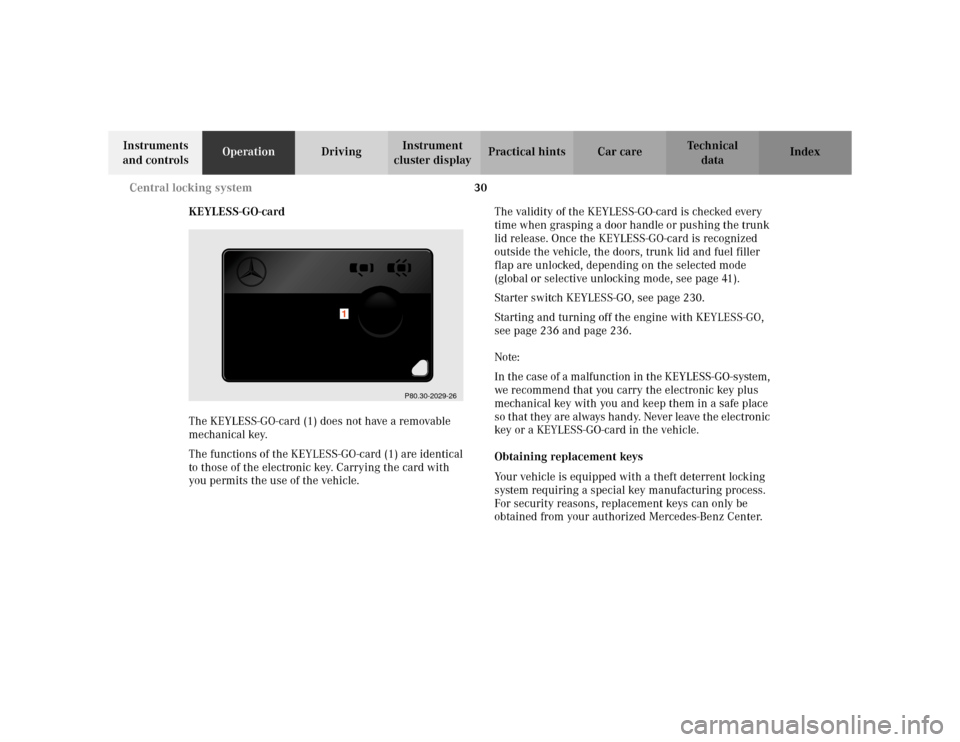
30 Central locking system
Te ch n i c a l
data Instruments
and controlsOperationDrivingInstrument
cluster displayPractical hints Car care Index
KEYLESS-GO-card
The KEYLESS-GO-card (1) does not have a removable
mechanical key.
The functions of the KEYLESS-GO-card (1) are identical
to those of the electronic key. Carrying the card with
you permits the use of the vehicle.The validity of the KEYLESS-GO-card is checked every
time when grasping a door handle or pushing the trunk
lid release. Once the KEYLESS-GO-card is recognized
outside the vehicle, the doors, trunk lid and fuel filler
flap are unlocked, depending on the selected mode
(global or selective unlocking mode, see page 41).
Starter switch KEYLESS-GO, see page 230.
Starting and turning off the engine with KEYLESS-GO,
see page 236 and page 236.
Note:
In the case of a malfunction in the KEYLESS-GO-system,
we recommend that you carry the electronic key plus
mechanical key with you and keep them in a safe place
so that they are always handy. Never leave the electronic
key or a KEYLESS-GO-card in the vehicle.
Obtaining replacement keys
Your vehicle is equipped with a theft deterrent locking
system requiring a special key manufacturing process.
For security reasons, replacement keys can only be
obtained from your authorized Mercedes-Benz Center.
P80.30-2029-26
1
Page 48 of 430
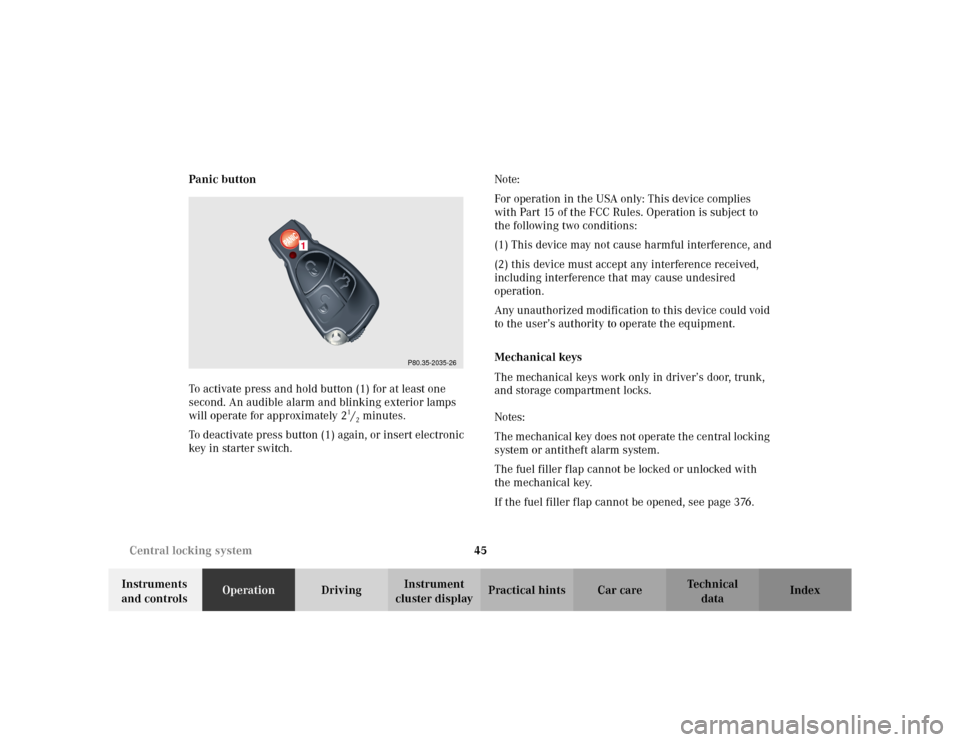
45 Central locking system
Te ch n i c a l
data Instruments
and controlsOperationDrivingInstrument
cluster displayPractical hints Car care Index Panic button
To activate press and hold button (1) for at least one
second. An audible alarm and blinking exterior lamps
will operate for approximately 2
1/2minutes.
To deactivate press button (1) again, or insert electronic
key in starter switch.Note:
For operation in the USA only: This device complies
with Part 15 of the FCC Rules. Operation is subject to
the following two conditions:
(1) This device may not cause harmful interference, and
(2) this device must accept any interference received,
including interference that may cause undesired
operation.
Any unauthorized modification to this device could void
to the user’s authority to operate the equipment.
Mechanical keys
The mechanical keys work only in driver’s door, trunk,
and storage compartment locks.
Notes:
The mechanical key does not operate the central locking
system or antitheft alarm system.
The fuel filler flap cannot be locked or unlocked with
the mechanical key.
If the fuel filler flap cannot be opened, see page 376.
P80.35-2035-26
1
Page 89 of 430
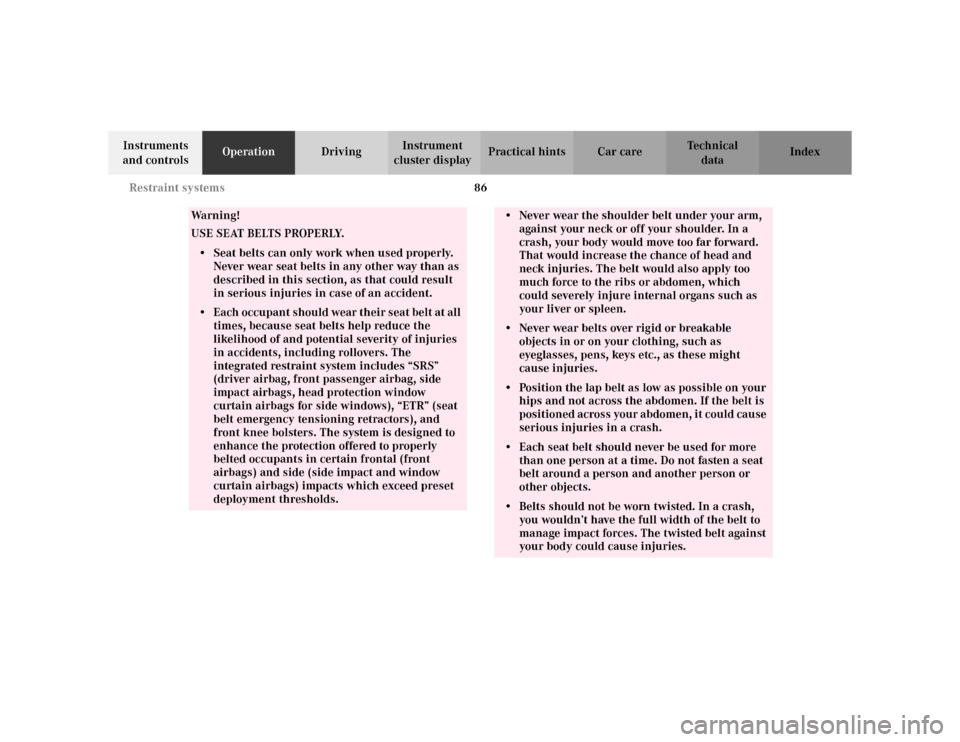
86 Restraint systems
Te ch n i c a l
data Instruments
and controlsOperationDrivingInstrument
cluster displayPractical hints Car care Index
Wa r n i n g !
USE SEAT BELTS PROPERLY.• Seat belts can only work when used properly.
Never wear seat belts in any other way than as
described in this section, as that could result
in serious injuries in case of an accident.• E ach oc c upan t s houl d wear t hei r s ea t bel t a t al l
times, because seat belts help reduce the
likelihood of and potential severity of injuries
in accidents, including rollovers. The
integrated restraint system includes “SRS”
(driver airbag, front passenger airbag, side
impact airbags, head protection window
curtain airbags for side windows), “ETR” (seat
belt emergency tensioning retractors), and
front knee bolsters. The system is designed to
enhance the protection offered to properly
belted occupants in certain frontal (front
airbags) and side (side impact and window
curtain airbags) impacts which exceed preset
deployment thresholds.
• Never wear the shoulder belt under your arm,
against your neck or off your shoulder. In a
crash, your body would move too far forward.
That would increase the chance of head and
neck injuries. The belt would also apply too
much force to the ribs or abdomen, which
could severely injure internal organs such as
your liver or spleen.• Never wear belts over rigid or breakable
objects in or on your clothing, such as
eyeglasses, pens, keys etc., as these might
cause injuries.• Position the lap belt as low as possible on your
hips and not across the abdomen. If the belt is
positioned across your abdomen, it could cause
serious injuries in a crash.• Each seat belt should never be used for more
than one person at a time. Do not fasten a seat
belt around a person and another person or
other objects.• Belts should not be worn twisted. In a crash,
you wouldn’t have the full width of the belt to
manage impact forces. The twisted belt against
your body could cause injuries.
Page 108 of 430
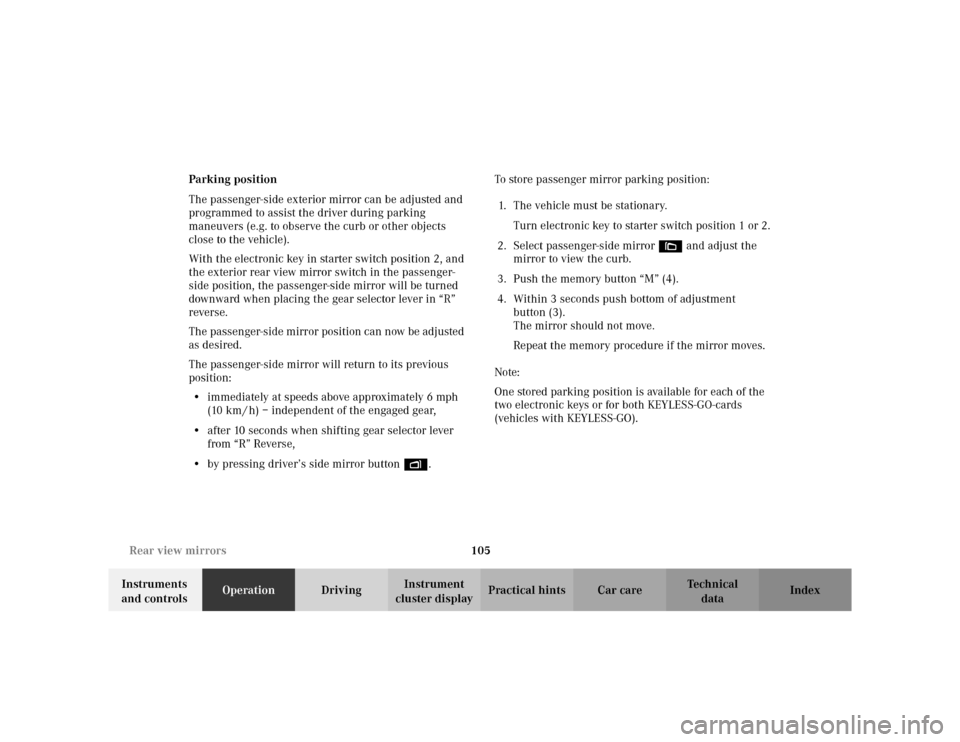
105 Rear view mirrors
Te ch n i c a l
data Instruments
and controlsOperationDrivingInstrument
cluster displayPractical hints Car care Index Parking position
The passenger-side exterior mirror can be adjusted and
programmed to assist the driver during parking
maneuvers (e.g. to observe the curb or other objects
close to the vehicle).
With the electronic key in starter switch position 2, and
the exterior rear view mirror switch in the passenger-
side position, the passenger-side mirror will be turned
downward when placing the gear selector lever in “R”
reverse.
The passenger-side mirror position can now be adjusted
as desired.
The passenger-side mirror will return to its previous
position:
•immediately at speeds above approximately 6 mph
(10 km / h) – independent of the engaged gear,
•after 10 seconds when shifting gear selector lever
from “R” Reverse,
•by pressing driver’s side mirror button %.To store passenger mirror parking position:
1. The vehicle must be stationary.
Turn electronic key to starter switch position 1 or 2.
2. Select passenger-side mirror& and adjust the
mirror to view the curb.
3. Push the memory button “M” (4).
4. Within 3 seconds push bottom of adjustment
button (3).
The mirror should not move.
Repeat the memory procedure if the mirror moves.
Note:
One stored parking position is available for each of the
two electronic keys or for both KEYLESS-GO-cards
(vehicles with KEYLESS-GO).
Page 111 of 430
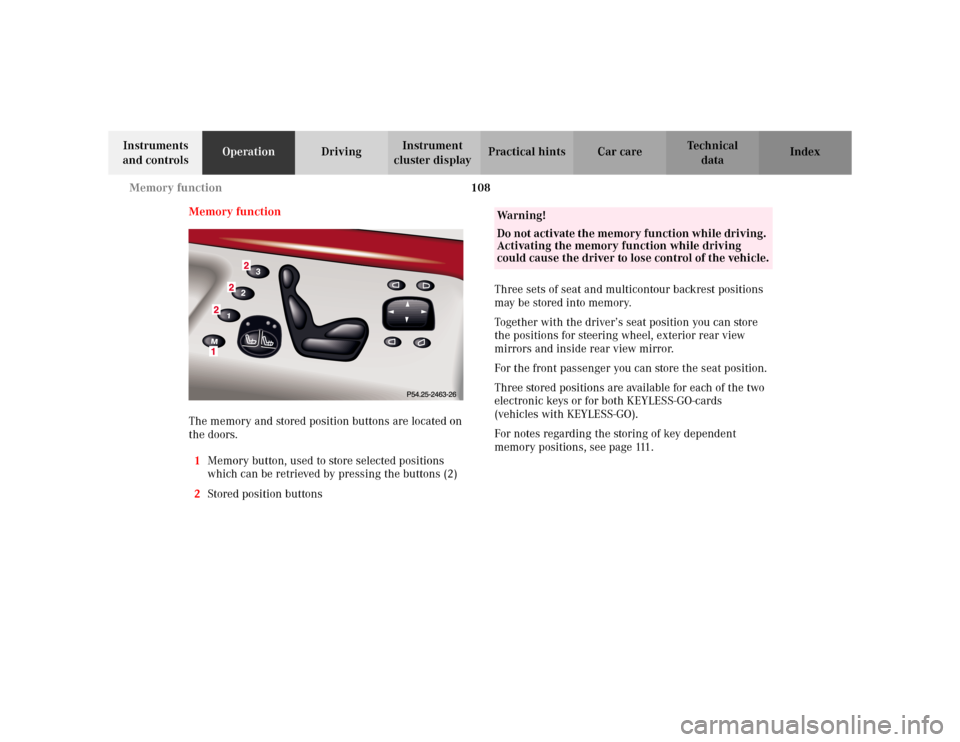
108 Memory function
Te ch n i c a l
data Instruments
and controlsOperationDrivingInstrument
cluster displayPractical hints Car care Index
Memory function
The memory and stored position buttons are located on
the doors.
1Memory button, used to store selected positions
which can be retrieved by pressing the buttons (2)
2Stored position buttonsThree sets of seat and multicontour backrest positions
may be stored into memory.
Together with the driver’s seat position you can store
the positions for steering wheel, exterior rear view
mirrors and inside rear view mirror.
For the front passenger you can store the seat position.
Three stored positions are available for each of the two
electronic keys or for both KEYLESS-GO-cards
(vehicles with KEYLESS-GO).
For notes regarding the storing of key dependent
memory positions, see page 111.
Wa r n i n g !
Do not activate the memory function while driving.
Activating the memory function while driving
could cause the driver to lose control of the vehicle.